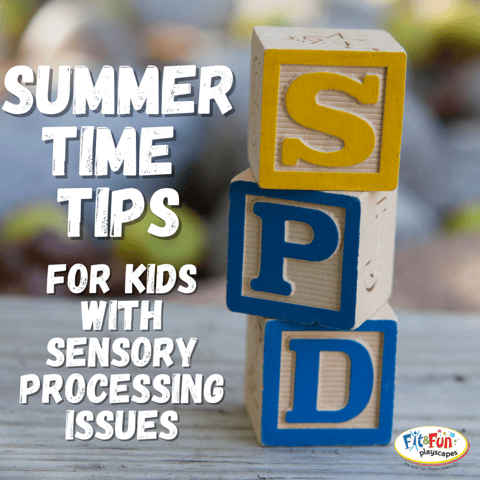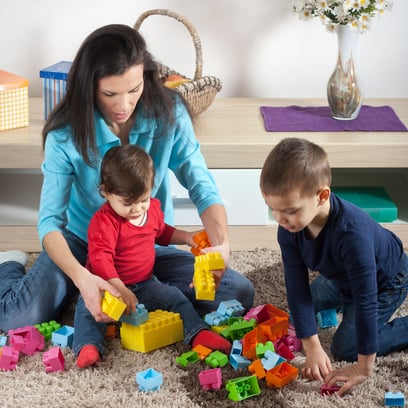Summertime Tips For Kids With Sensory Processing Disorder (DCD)
Kids with sensory processing disorder (DCD) can become easily overwhelmed in the summertime. What are some ways to help?
What Is Sensory Processing Disorder (DCD)?
Sensory processing issues, also known as Sensory Processing Disorder, is a condition where the brain has trouble receiving and responding properly to sensory input signals like touch or sound. The condition affects both children and adults and may manifest itself in a wide range of symptoms.
In children, symptoms of a sensory processing issue may include sudden temper-tantrums or crying fits at seemingly common sounds, like a door shutting or a dog barking. Children with sensory processing issues may also recoil in disgust and vomit at certain food textures, scream when touched, or even frequently bump into walls or people.
First identified in the 1970s by occupational therapist Dr. A. Jean Ayers, sensory processing issues do not just affect the five common senses – touch, taste, smell, sight, sound — but seven. Ayers identified two more senses — proprioceptive and vestibular senses — which Dr. Tim Davis broke down magnificently in a series of guest blog posts right here on the Fit and Fun website!
According to the University of California, San Francisco, sensory processing disorders effect five to 16% of all school-aged children.
Summertime Tips For Helpings Kids With SPD
In a wonderful article from Understood.org, an organization that helps parents who have kids with learning disabilities, author Amanda Morin discusses a relevant topic that gets little to no attention.
“Summer is a time for relaxing,” Morin writes, "but some of the sounds, smells, and sensations that come with the fun can overwhelm kids with sensory processing issues.”
During the summer months, when everyone is outside and enjoying the nice weather, parents who have kids with these special sensitivities often find themselves overwhelmed. In her article, Morin identifies eight ways that parents with kids with sensory processing issues can “challenge” themselves.
We’ve decided to add a few more to her list:
- Sit on the grass. Because kids with sensory processing issues can become easily overwhelmed by the pricking sensation of grass on the skin, especially when it gets hot, pick a cool spot in the shade. Let your child run their hands first through the grass until they’re comfortable. Then, if able, have them take their shoes off!
- Limit sun exposure. Summer gets hot! Sometimes, kids with sensory processing issues can become easily agitated under the hot sun, especially at the beach or during a sporting event. If you’re one of the estimated 60 million Americans who will go to the beach this summer, make sure to bring an umbrella or two. Better yet, bring a tent specially designed to keep kids cool and relaxed. And don’t forget the sunscreen!
- The quieter the better. Kids with sensory processing issues can often become suddenly overwhelmed by seemingly everyday noises. The sound of a motorcycle, the clunk-clunk of feet on a boardwalk, or even another child's joyful screams can change a calm day into a nightmare scenario for parents in the briefest moments. If your options are limited, try to get away from the crowds as best as you can. If you can't, try the next option.
- Bring a sensory kit. A sensory kit is a small, portable collection of items you can access should your child become overwhelmed. The kit does not need to be complicated: it can be a change of comfortable clothes, a fidget spinner, something to cover their eyes (sunglasses or a soft towel), and ear plugs. Use the sensory kit sporadically throughout the day, or use it in an emergency situation, should the need arise.
- Plan your day in advance. You're less likely to get into a sticky situation with your child if you plan your day in advance. Children with SPD often thrive on structure, which is why maintaining that structure is so critical over the summer months when school can't provide it. Map out where you're going to go when, and if your child is of age to understand, inform them too. Try not to make any sudden changes or unplanned stops along the way - unless, of course, emergency dictates. If you must make a stop, offer a reward to your child, such as a snack or an item from your sensory kit, and be sure to inform them of why the stop must be made.
PSA: Warning Signs of Sensory Overload!
Every child is different, so the warning signs of an impending sensory overload episode vary depending on who the child is. Parents, of course, know their children best, so they tend to be the most in-tune with what signs to look out for.
With that being said, there are commonalities that many children share, especially during the hot summer months. Here are a few to watch out for:
- Anxiety. You might think this one is easy to look out for, but not all children exhibit symptoms of anxiety equally. Some children will hide behind their parents, breathe rapidly, or even show signs of hyperactivity. Other children will seem to zone out and have trouble focusing on one thing. You know your child best - pay attention to their behavior.
- Sweating. This one is pretty simple to see, but how can you tell the difference between sweating caused by sensory overload and sweating because it's hot out? Once again, knowing your child is key. Pay close attention for other warning signs to pair with sweating, such as dizziness, anxiety, or restlessness.
- Headache/Dizziness. Children will often get a headache and/or become dizzy when they are overstimulated. Younger children, or those with more severe disabilities, may not be able to just say, "My head hurts," or "I have a headache." Look for signs of a headache, such as covering the eyes, rubbing the temples, or seeking out darker spaces.
- Vomiting. Yes, if children are severely overstimulated, they will vomit. Vomiting, just like tantrums, is one of the most clear warning signs of sensory overload. If your child begins to vomit, it's time to move them to a quieter, cooler area.
- Tantrums. The warning sign we all know. Tantrums can happen anywhere, anytime, and it's not fun for anyone. If your child has a tantrum caused by sensory overload, consider breaking out the items in your sensory kit. Scolding the child in this scenario will not help. If scolding is necessary, wait until after the child has calmed down.
- Covering the eyes and/or ears. Children who are overstimulated tend to try and cover their eyes and/or ears to block out incoming sensory stimuli. Sometimes, this symptom will be paired with tantrums, vomiting, sweating, or flushed cheeks.
- Restlessness. This particular symptom is harder to spot, especially because a child who is restless may just appear to have a lot of energy. If you've been out in a chaotic environment for a long time and your child seems to have unlimited energy, is having trouble focusing, and isn't listening to you, you may have a child who is overstimulated.
- Sensitivity to fabrics and/or textures. Is your child suddenly tugging at their clothes? Are they scratching their body a lot? Do they seem to recoil from specific textures, like a hot leather car seat or the pavement? Sudden sensitivity to fabrics and textures is another warning sign of sensory overload, which is why we recommend packing some comfortable clothes in your sensory kit!
Using An Outdoor Sensory Pathway To Manage Children With Sensory Processing Disorders
Oh no! You've taken your child to the park and they are having a sensory overload episode. You turn to pull your sensory kit from your bag, only to discover you've forgotten it. Now what do you do?
Luckily, you notice a series of colorful patterns on one of the park's many walkways. One of the colorful patterns looks like a series of painted logs - another like bear prints. You wonder if it can help your child, who is now throwing a tantrum in the middle of the sandbox. Other parents are starting to stare.
Quickly, you bring your child to this walkway. After a little quiet time away from the chaos of the playground, your child begins to interact with the patterns. Your child jumps from log to log, walks on their hands/feet like a bear. Within a few moments, your child has relaxed. You're amazed and left wondering what this amazing new thing is.
No worries: you needn't wonder. You've discovered the magic of outdoor sensory pathways!
A sensory pathway is a colorful, creative, and playful way for kids to build connections in the brain that are responsible for sight, touch, sound, etc., which enable kids to complete complex, multi-stage tasks. A sensory pathway is a great way for kids to develop motor skills like balance, hand-eye coordination, and spatial awareness. However, you've found that outdoor sensory pathways, made with painted Reusable Stencils, have another added benefit, if utilized properly: they can be used to relax a child who is overstimulated.
The key here is re-focusing the child's overstimulated brain on something else - namely, the activities of the pathway. While it's important to first calm your child down if they are showing signs of overstimulation (such as throwing a tantrum, fidgeting, crying, etc.), the sensory pathway is a great transitional activity that can be used to re-introduce your child to the chaotic summer playground environment once everything is settled. Or, in a pinch - especially if your child is showing restlessness - the sensory pathway can be used to re-focus their brains on their body, easing that unfocused restlessness.
Should you live near a park with one of these sensory tools, we recommend trying it out. Let us know how it goes!
Do you have a child with sensory processing disorder? If so, what are some precautions you take when going out?
-------------------------
Originally published 6/13/19. Republished 4/5/21. Updated 4/1/22




%203.png?width=480&name=Generic%20Blog%20Photo%20(Square)%203.png)
.jpg?width=480&name=Rasmussen1_480x480%20(1).jpg)

Leave a comment